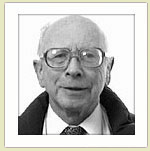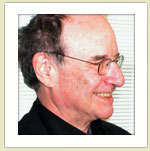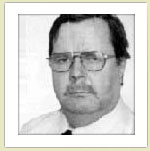|
 Dr.
Arthur Pardee, professor emeritus of biological chemistry and molecular
pharmacology, Dana-Farber Cancer Institute and Harvard Medical School
Dr.
Arthur Pardee, professor emeritus of biological chemistry and molecular
pharmacology, Dana-Farber Cancer Institute and Harvard Medical School
"This gathering
is a very high-powered conference. The people here are some of the
best people in the field. This meeting harks back to the origins
of all of the important work in molecular biology. The pioneers,
the people who made all of this work possible, are here. In science,
you have to build one thing on top of another, and many of the people
at this conference laid the foundation for everything that's followed."
What Dr. Pardee didn't say is that he is one of those pioneers.
He invented a technique that allows scientists to identify and study
the small number of genes that distinguish one cell from another.
 Dr.
Sydney Brenner, who won the Nobel prize in Physiology or Medicine
in 2002, reminisced during the opening session about research in
the early fifties and the impact of the double helix discovery.
(To watch our Webcast conversation with Dr. Brenner,
click
here
.)
Dr.
Sydney Brenner, who won the Nobel prize in Physiology or Medicine
in 2002, reminisced during the opening session about research in
the early fifties and the impact of the double helix discovery.
(To watch our Webcast conversation with Dr. Brenner,
click
here
.)
"In those days we were on crutches. Not only were we on crutches,
our hands were tied behind our backs. . . . I belong to that old-fashioned
class that likes to do things with their hands tied behind their
backs. . . . I saw the model [Watson and Crick's original 3-D model
of DNA] on April 16, 1953. . . . What gripped me was not the model
itself but the implications of it, the biological significance of
what it would do. That is what we have been dealing with all these
years."
 Dr.
Walter Gilbert, who won the Nobel prize in Chemistry in 1980, summarized
the accomplishments of the last century and speculated on future
directions and questions for basic research.
(To watch our
Webcast conversation with Dr. Gilbert,
click
here
.)
Dr.
Walter Gilbert, who won the Nobel prize in Chemistry in 1980, summarized
the accomplishments of the last century and speculated on future
directions and questions for basic research.
(To watch our
Webcast conversation with Dr. Gilbert,
click
here
.)
On the discovery
of the double helix:
"The important thing is not the structure but that it gave
us a way to understand how the information is copied."
On the future work to be done:
"The basic science will be done by people comparing the genes
between different organisms."
On what the next decade will bring:
"DNA databases will transform criminology."
"All human protein-to-protein interactions will be identified
but not understood."
"Evolutionary comparisons will become ever more important."
On the deeper problems in genetics research:
• The causes of disease and modification of disease processes
• The control of growth of organs
• The origin of life and the RNA* world
• The nature of memory and thought
*RNA, or ribonucleic acid, is chemically similar to a single strand
of DNA.
RNA serves as the messenger between DNA and the cytoplasm in the
cell
where proteins are made. Understanding the relationship between
the messenger RNA and ribosomes, the protein factories in the cytoplasm,
will be a key to understanding how life evolved.
 Petter
Portin, professor of genetics, University of Turku, Finland
Petter
Portin, professor of genetics, University of Turku, Finland
"I'm very excited to be here celebrating the fiftieth anniversary
of the discovery of the structure of DNA. I have a poster here describing
the early history of the DNA theory of inheritance. I teach theoretical
biology and its history, so it's been very interesting to listen
to the historical perspectives of DNA, especially to Sydney Brenner
telling us about when he first saw the Watson and Crick model. He
was among the first to really realize the importance of the Watson
and Crick model, to see its biological implications."
"Find
the soul in that blastocyst and tell me how it got there!"
Dr. James Watson, chatting informally over lunch with Exploratorium
staffers on the challenge of doing science in the face of religious
fundamentalism.
more
dispatches »
|

 Dr.
Arthur Pardee, professor emeritus of biological chemistry and molecular
pharmacology, Dana-Farber Cancer Institute and Harvard Medical School
Dr.
Arthur Pardee, professor emeritus of biological chemistry and molecular
pharmacology, Dana-Farber Cancer Institute and Harvard Medical School
 Dr.
Sydney Brenner, who won the Nobel prize in Physiology or Medicine
in 2002, reminisced during the opening session about research in
the early fifties and the impact of the double helix discovery.
(To watch our Webcast conversation with Dr. Brenner,
Dr.
Sydney Brenner, who won the Nobel prize in Physiology or Medicine
in 2002, reminisced during the opening session about research in
the early fifties and the impact of the double helix discovery.
(To watch our Webcast conversation with Dr. Brenner,
 Dr.
Walter Gilbert, who won the Nobel prize in Chemistry in 1980, summarized
the accomplishments of the last century and speculated on future
directions and questions for basic research.
(To watch our
Webcast conversation with Dr. Gilbert,
Dr.
Walter Gilbert, who won the Nobel prize in Chemistry in 1980, summarized
the accomplishments of the last century and speculated on future
directions and questions for basic research.
(To watch our
Webcast conversation with Dr. Gilbert,
 Petter
Portin, professor of genetics, University of Turku, Finland
Petter
Portin, professor of genetics, University of Turku, Finland